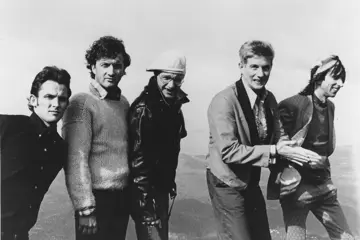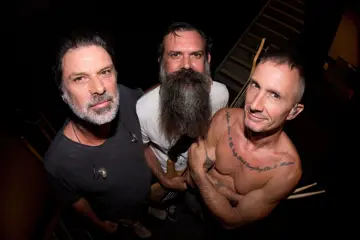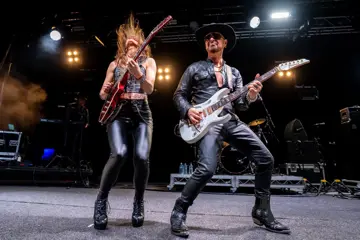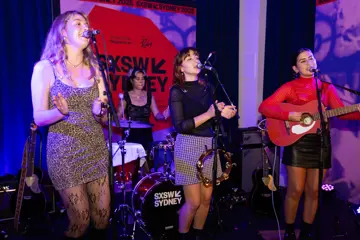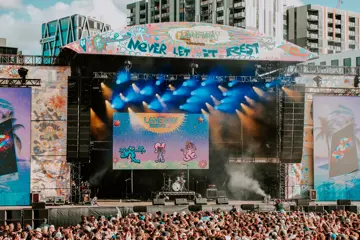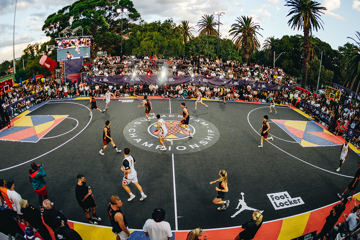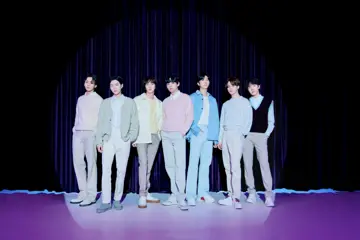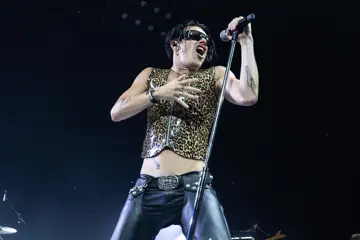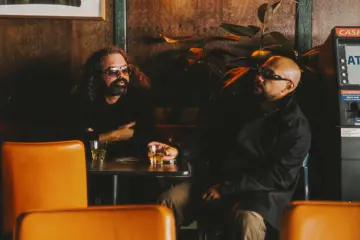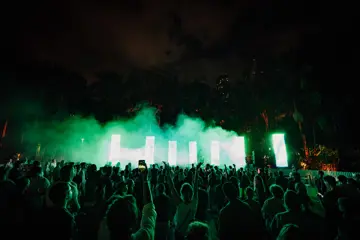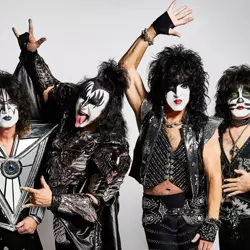 KISS
KISSIt was a year where the Australian and global music industry was still feeling the effects of COVID – huge spectacles and new sounds as fans rediscovered the thrill of music more on their own terms than before, versus grassroots finding ways to survive as they came up with some of the best music ever.
Here are seven music industry takeaways from 2023.
1. Fans Consumed Music In More Ways & For Longer
Fans consumed more music than ever across the world in 2023, on average using seven methods. They listened to 20.7 hours a week (from 20.1 hours in 2022) and consumed at least eight genres each although Pop remained the most popular.
This was according to London-based IFPI’s (International Federation of Phonographic Industries) Engaging With Music 2023 report published in mid-December, from responses of over 43,000 people across 26 countries.
Audio streaming continued to grow, with 73 percent using it, and with a seven percent rise in time spent on these services. The younger the fans, the more they embraced subscription streaming. It was a 60 percent rate for the 16-to-24 age group and 62 percent for the 25-to-34 demo, compared to 50 percent for 35-to-44 year olds and 28 percent for the 55-to-64 group.
Don't miss a beat with our FREE daily newsletter
For 16-to-24-year-olds, 82 percent opted to hear music on short form video platforms like TikTok, versus 72 percent for audio streaming, 68 percent for video streaming platforms and 48 percent for radio.
64 percent of 16-to-44-year-olds liked discovering older music, and 80 percent of gamers had music on as they played. 71 percent found music important for their mental health and wellbeing and 78 percent found it helped them relax and cope with stress.
In 2023, the morality/legality arguments versus the creative opportunities of artificial intelligence (AI) came to the fore. 89 percent of fans were aware of the doors it opened. But 70 percent wanted rules set up for its use, with 74 percent adamant AI should not be used to clone or impersonate an artist without permission.
2. Aussies Headed To Stadiums But Small Venues In Crisis
The top end of the Australian live market was a complete cashbox, as attendance and tour profit records fell like dominoes.
A PWC forecast of a 30.8 percent compound annual growth rate between 2021 and 2026 put Australia as the second fastest growing live sector in the world.
Taylor Swift, Paul McCartney, Elton John, Coldplay and Robbie Williams represented the A-listers while P!nk, Harry Styles, Foo Fighters, IDLES, and Sam Fender made transitions to larger venues.
Live Nation Australia, Frontier Touring and TEG had their biggest year, and 2024 already promises to be as massive. Independent operator Untitled Group shifted 400,000 tickets from July 2022 to June 2023, and is targeting 500,000 tix from 400 events between July 2023 and June 2024.
But this top-end buoyancy didn’t drift down to the mid-league which had to fight harder to maintain production costs, punter support and media interest. Untitled’s Filippo Palermo said, “One of the most notable effects of these large stadium tours is the diversion of ticket sales and audience attention.”
Certainly small-to-medium venues were hurting. Crowds were not returning to pre-pandemic levels, and rents and operational costs were up. Statistics from APRA AMCOS showed Australia lost one-third of small- to mid-size venues (or 1,300) from COVID. The organisation’s live performance royalties were up 400 percent, but less from such venues.
It was a wake-up call when Adelaide’s Enigma Bar and Newcastle’s Cambridge Hotel gave up the fight after decades of live music, and Badlands and The Sewing Room in Perth turned the lights off after their public liability insurance went up tenfold. Mo’s Desert Clubhouse on the Gold Coast admitted, “Times are hard because of all the free events in the area.” Venues are further hurting as cash-strapped punters are cutting back on alcohol and food buys, and buying tickets later.
3. Hip Hop’s 50th Birthday Spotlighted Pioneers
Media attention on hip hop’s 50th celebrations – including an ARIA awards feature and widespread release of Sensible Antixx’s Burn Gently doco – allowed original Australian pioneers as 1200 Techniques, (N’fa Jones and DJ Peril), Sound Unlimited Posse and Def Wish Cast to be spotlighted.
1200 Techniques and Def Wish Cast also featured in 4ESydney 2023 conference in Sydney which outlined strategic growth plans for the genre. The celebrations also showed off the zazziness of new blood like ECB, Gold Fang, VV Pete, Mulalo, Babyface Mal and Forest Claudette.
To remind non-believers that hip hop still had sassitude, Genesis Owusu made headlines when he called for a ceasefire in Gaza and “freedom for the Palestinians” when he picked up his ARIA for best album during the telecast, rappers led music’s support for the Voice referendum, DEM MOB crossfired at the South Australian Music Awards, and Western Sydney drillers OneFour continued to haunt the NSW Police (and vice versa).
4. Cost Of Living Tested Music Fans’ Loyalty
The UK’s largest nightclub operator REKOM UK believed that the nightclub scene was resilient. It was hardly affected by the 1991 and 2008 recessions. But this year its research found that a high 77.3 percent of Brits drastically cut down on the times they went out clubbing.
Six months ago, when inflation was running at seven percent in Australia, loyalty was still kicking in. Younger Aussies cut back on takeaways, travel and even pets. But 73 percent maintained entertainment subscriptions, and 75 percent had no plans to cut back on buying CDs, DVDs, books, magazines and games. How that changed through 2023 as the crisis worsened remains to be seen with new data.
A May 2023 report from the Australia Council warned that under-35s were most likely to cut back on arts (and music) events as they tend to spend $50 each time, were drawn to discounts, and becoming partial to local events as 45 percent of the demo made the choice to drive less to save on petrol.
Cost of living was a nightmare for indie musicians without label support. Production costs were up by 40 percent but a parallel bumping up of ticket prices to compensate was out of the question. It meant slashing marketing and production and relying more on day jobs. A regional gig meant driving back home overnight rather than stay in a motel.
5. More Aussies Tuned In To Community Radio
The Community Radio Listener Survey by McNair yellowSquares of 16,000 Australians over the age of 15, reported that community radio reached over 4.71 million every week, with each listener spending an average of 14.9 hours. 29 percent of all radio listeners listen to community radio.
The use of Amrap.org.au grew, as did the diversity of the music and artists it represents and promotes, and the sector collaborated in news gathering with the ABC. The Community Broadcasting Association of Australia released Roadmap 2033, a ten-year plan for the sector to engage with more sector stakeholders.
The sector launched digital radio services for three stations on the Gold Coast, its Community Radio Plus app developed new functionality including popular car app and smart speaker compatibility and station guides, and the Online Community platform was launched as a space for members to share knowledge and seek guidance.
6. The Taylor Swift Factor
No look-back at 2023 would be complete without a mention of how Tay-Tay not only completely dominated music but the world. Time magazine even made her person of the year ahead of Barbie!
By the end of the year, Pollstar was reporting that her Eras world tour had made over US$1 billion – and further predicted it would click over another $1 billion by the end of 2024. Next year she goes back on the tour in February with four shows at the Tokyo Dome in Japan, seven in Australia, six in Singapore, 50 in Europe and a return to North America.
This year Eras was making $14 million per show. In addition, she was this year’s most-streamed artist globally on Spotify, with over 26.1 billion global streams there since January 1.
There were astounding figures in Australia as well. When the tour was announced, 4 million vied for a reported 680,000 seats. Bookings at the Hilton Melbourne shot up 9400 percent and 1129 percent at the Sydney Hilton while domestic flight searches to the two cities around the time of the shows leaped 282 percent and 151 percent, respectively.
The demand for all things Taylor was relentless. The Victorian government had to use its powers to stop scalpers from making a killing. How relentless? At the Robert Allenby / Challenge Golf Dinner at Crown in Melbourne, two A-reserve tickets for the Melbourne show binged $10,000 at a charity auction.
With a budget of $10 million to $20 million using footage from her August shows at SoFi Stadium in California, The Eras Tour movie generated a $92.8 million gross in its first weekend and instantly laid the flag as the top-grossing concert film in history. It had grossed $250 million by end of November according to distributor AMC Theatres.
In Australia, it opened with $3.8 million on 480 screens and done $5.99 million. In comparison, Barbie opened with $19.6 million in its first weekend in Australia from 765 screens and generated $85.8 million so far. Its world gross to date is $1.44 billion.
7. The Era Of Full Hologram Concerts
With so many acts announcing farewell tours, we’ve now entered the era where they can extend these perpetually with full concerts as digital avatars.
ABBA’s digital 90-minute Voyager concert is currently looking at staging around the world after drawing 1.6 million fans over 550 shows since opening in May 2022 in London, turning over $2 million each week. The custom-built spaceship-style ABBA Arena in London includes three 65-million-pixel screens which provide a convincing 3D depth.
Now KISS have teamed up with the same Sweden-headquartered Pophouse Entertainment, which put Voyager together at a cost of $175 million over seven years. George Lucas’ Industrial Light & Magic, best known for its remarkable work on Star Wars, provided special effects.
KISS’ three-year End Of The Road tour grossed between $150 million and $200 million, during which time Gene Simmons turned 70. Simmons, who said he "made millions every year for more than 40 years" by being a super-character that couldn’t age, has admitted he’s always looking ways to make more money. Living on as an avatar is the next logical step. KISS won’t be the only ones in the future to take that route. The fans seem ready.

